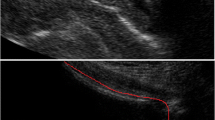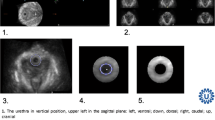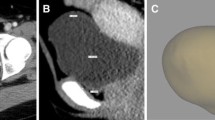Abstract
Introduction and hypothesis
The aim was to validate ultrasound bladder wall thickness measurements. We scanned at three frequencies (5 MHz, 7 MHz and 9 MHz), using two techniques described in clinical practice and compared them with direct micrometre calliper measurements.
Methods
Bladder dome cadaver specimens were dissected from male and female cadavers. The direct micrometre calliper measurement under direct vision was used as the gold standard. We imaged using a Voluson E8 ultrasound scanner at three frequencies, using three probes: AB27D (2-7 MHz), RAB25D (2-5 MHz) and RIC50D (5–9 MHz). The specimens were scanned on two different occasions for intra-observer variability. A second operator, measured the samples again independently for the interobserver agreement. The specimens were gently placed onto a sheathed and gelled probe to avoid deformation. The method of scanning was the same for all the specimens, probes and operators.
Results
Twenty-five bladder dome specimens were assessed. The correlation of the ultrasound measurement to the direct measurement improved at higher ultrasound frequencies. Measuring from the inside of the serosal hyperechogenicity also increased the accuracy correlation with the direct measurement for all the frequencies tested.
Conclusions
This is the first study validating BWT ultrasound measurements against cadaveric bladder wall calliper measurements. Technology and technique affect accuracy, which is important in clinical practice. The use of 5-MHz probes is not recommended. The most accurate measurement was obtained using high-frequency ultrasound, where the measurement did not include the serosal brightness. These data suggest that high-frequency ultrasound should be used to assess BWT.


Similar content being viewed by others
References
Khullar V, Salvatore L, Cardozo L, Bourne TH, Abbott D, Kelleher C. A novel technique for measuring bladder wall thickness in women using transvaginal ultrasound. Ultrasound Obstet Gynecol. 1994;4:220–3.
Panayi DC, Tekkis P, Fernando R, Hendricken C, Khullar V. Ultrasound measurement of bladder wall thickness is associated with the overactive bladder syndrome. Neurourol Urodyn. 2010;29:1295–8.
Robinson D, Anders K, Cardozo L, Bidmead J, Toozs-Hobson P, Khullar V. Can ultrasound replace ambulatory urodynamics when investigating women with irritative urinary symptoms? BJOG. 2002;109:145–8.
Latthe P, Middleton L, Rachaneni S, McCooty S, Daniels J, Coomarasamy A, et al. Ultrasound bladder wall thickness and detrusor overactivity: a multicentre test accuracy study. BJOG. 2017;124:1422–9.
Bray R, Cartwright R, Cardozo L, Hill S, Guan Z, Khullar V. Tolterodine ER reduced increased bladder wall thickness in women with overactive bladder. A randomised, placebo-controlled, double-blind, parallel group study. Neurourol Urodyn. 2018;37:237–43.
Robinson D, Oelke M, Khullar V, Wijkstra H, Tretter R, Stow B, et al. Bladder wall thickness in women with symptoms of overactive bladder and detrusor overactivity: results from the randomised, placebo-controlled shrink study. Neurourol Urodyn. 2016;35:819–25.
Oelke M, Khullar V, Wijkstra H. Review on ultrasound measurement of bladder or detrusor wall thickness in women: techniques, diagnostic utility, and use in clinical trials. World J Urol. 2013;31:1093–104.
Muller L, Bergstrom T, Hellstrom M, Svensson E, Jacobsson B. Standardized ultrasound method for assessing detrusor muscle thickness in children. J Urol. 2000;164:134–8.
Akselim B, Doganay M, Ozcan N, Akselim S, Cavkaytar S. Correlation of bladder wall thickness and treatment success in types of urinary incontinence. Int Urogynecol J. 2017;28:417–22.
Author information
Authors and Affiliations
Corresponding author
Ethics declarations
Conflicts of interest
None.
Electronic supplementary material
Supplementary Table 5
(DOCX 15 kb)
Supplementary Table 6
(DOCX 12.5 kb)
Rights and permissions
About this article
Cite this article
Asfour, V., Gibbs, K., DaSilva, A.S. et al. Validation study of ultrasound bladder wall thickness measurements. Int Urogynecol J 30, 1575–1580 (2019). https://doi.org/10.1007/s00192-018-3802-4
Received:
Accepted:
Published:
Issue Date:
DOI: https://doi.org/10.1007/s00192-018-3802-4




